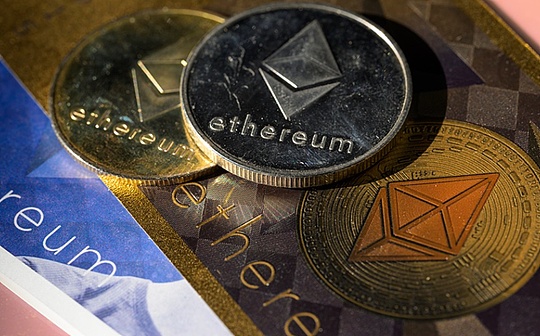
Source: Chainalysis; Compilation: Deng Tong, Bitchain Vision
Latin America is the fifth largest region in our study, accounting for 9.1% of the value of cryptocurrencies received between July 2023 and June 2024.During this period, the region received nearly $415 billion in cryptocurrency, slightly higher than East Asia.
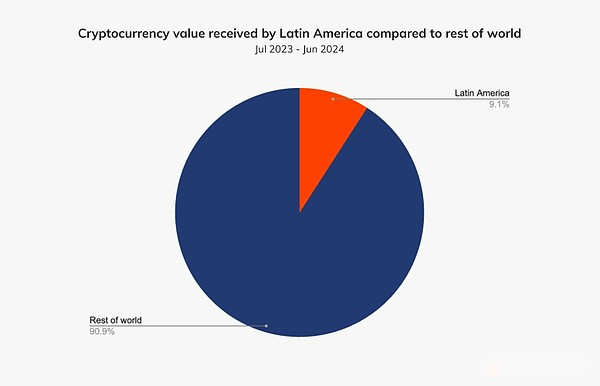
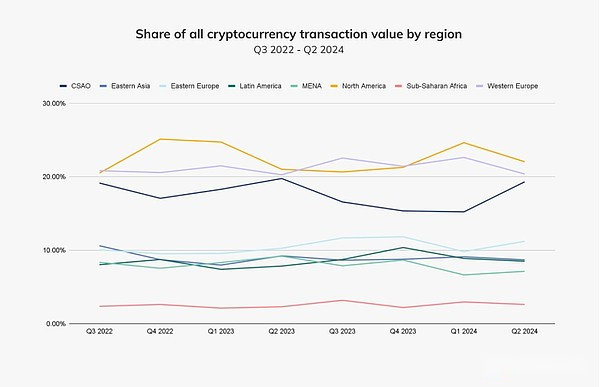
Centralized exchanges (CEXs) are the most commonly used service for Latinos, accounting for 68.7% – slightly lower than North American CEX usage.Regional transaction value in Latin America is driven primarily by institutional and professional investors (i.e. entities with transaction volumes of more than $10,000).
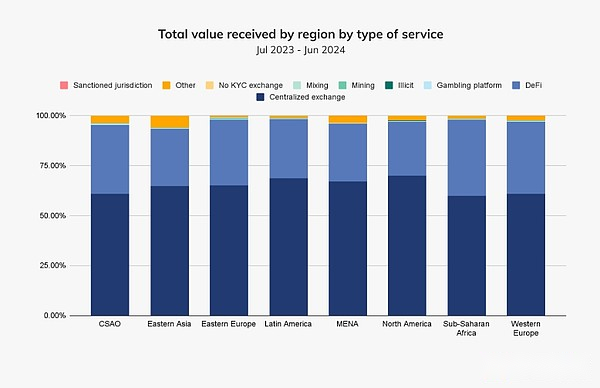
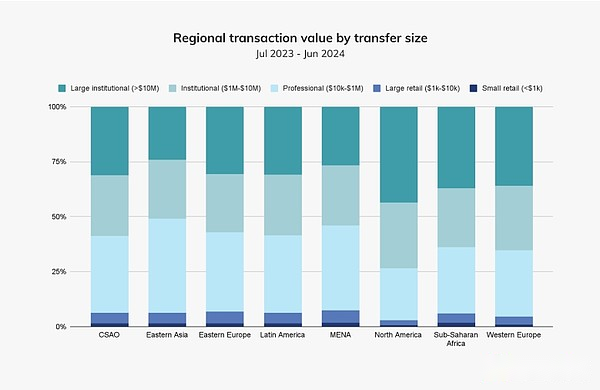
Latin America is the second fastest growing region we have studied this year, with a year-on-year growth rate of about 42.5%.As we will explore later, this growth is mostly driven by strong but diversified cryptocurrency markets in Venezuela, Argentina and Brazil.

In terms of cryptocurrency value, Argentina ranks first in the region, with an estimated $91.1 billion, just slightly higher than Brazil’s $90.3 billion.
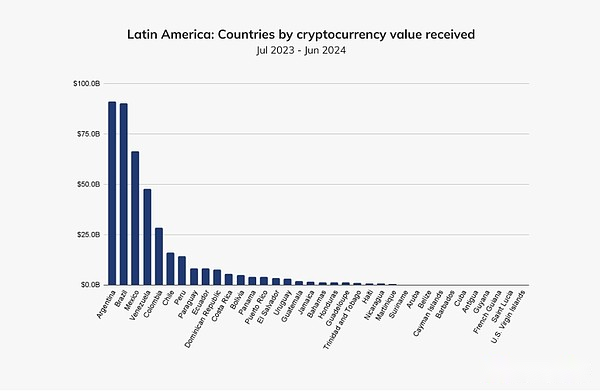
In our global adoption index, 4 of the top 20 countries are located in Latin America: Brazil (9), Mexico (13), Venezuela (14), and Argentina (15).As we will explore in detail below, stablecoin-based remittances are becoming increasingly popular in these countries, as well as in Latin America as a whole.

Brazilian institutional cryptocurrency activity shows major financial institutions rekindled interest
In last year’s Geos report, we noticed thatAlthough Brazil has historically had a well-developed institutional cryptocurrency market, institutional activity declined in early 2023, which could be concurrent with a global cryptocurrency bear market.But this trend reversed mid-year and has increased since then, indicating a renewed interest in major financial entities.For example, the monthly value of institutional-scale transactions (i.e., over $1 million) increased by about 29.2% between the last two quarters of 2023 and about 48.4% between the fourth quarter of 2023 and the first quarter of 2024.
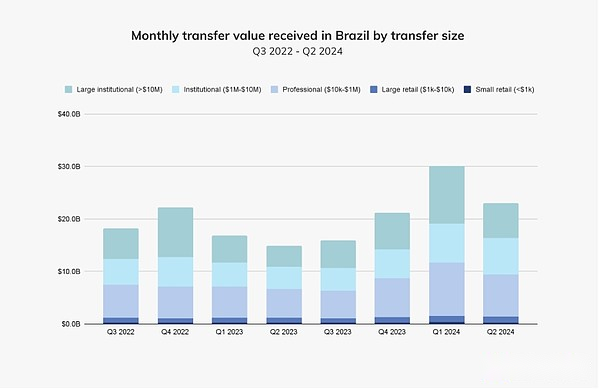
We interviewed André Portilho, head of digital assets at investment bank BTG Pactual, to learn more about the factors driving this institutional activity.“A key factor is portfolio diversification, especially as the market matures. Investors are increasingly integrating digital assets into their asset allocation strategies, viewing them as valuable alternative investments with the potential to increase returns. The integration of Bitcoin and other cryptocurrencies as established investment options is crucial in this transition,” he explained.“The significant recovery in Brazil’s crypto asset institution activity can be attributed in part to the evolution of regulation and the entry of US institutions into cryptocurrency markets, especially with the launch of Bitcoin and Ethereum ETFs.”
Aaron Stanley, founder of the Brazil Crypto Report, a newsletter and podcast exploring the latest trends in Brazil’s crypto ecosystem, notes that Brazil embraces similar trends in crypto.“The ecosystem is quite mature. We have seen several TradFi banks launching crypto brokerage products (for example, Itaú, the largest bank in the country), and most other major banks are actively building their own similar products. We see OKX andMajor global exchanges such as Coinbase have been launched in the country with tough launches and are equipped with local teams and entities. The Drex pilot program is a hybrid CBDC/smart contract platform being developed by the central bank of Brazil, which has also prompted TradFi banks to be more forward-looking in their digital asset strategy.This has a downstream benefit for these institutions and their customers in terms of cryptocurrency adoption.”
As Brazilian cryptocurrency activity flourishes, we provide a detailed analysis of the most popular assets among Brazilians.First, we found that Bitcoin transactions grew the most during the research period.The value of Bitcoin transactions has seen a particularly dramatic increase between September 2023 and March 2024, which may be consistent with the time when the SEC approved the spot Bitcoin ETF in January 2024.It is also worth noting that during this period, the price of Bitcoin has almost doubled, which may lead to a rise in Bitcoin prices.Contributed to these higher sales.

A closer look at this Bitcoin activity reveals that Brazilians receive much more value on global exchanges than they receive on regional local exchanges.

However, there is a sharp contrast in the types of assets traded on local exchanges.As shown below, stablecoin transactions on local exchanges increased significantly year-on-year (207.7%) than Bitcoin, Ethereum and altcoins.Stanley noted, “Many exchanges and fintech brokers in Brazil offer stablecoins pegged to their clients, with the idea of providing dollar exposure as a means of store of value. This has undoubtedly attracted attention, but inAt this stage, the main use case of stablecoins seems to be in B2B cross-border payments.”

Currently, stablecoins account for approximately 70% of the indirect traffic share flowing from Brazilian local exchanges to global exchanges.Brazil’s high level of stablecoin activity and widespread interest in digital products and services has attracted great interest from major cryptocurrency players, especially Circle, which announced its official launch in May 2024 in Brazil.A Circle spokesman said, “Circle’s participation in Brazil’s regulatory certainty has increased due to policies and initiatives that encourage innovation, and more business-friendly rules are expected to be formulated in the near future. We are working with leading regional businesses,Launching digital asset products to provide Brazilian users with nearly instant, low-cost, 24/7 USDC access and strengthen our local business to reach a wider user base. Thanks to commitment to the region and existing partnerships, the number of users in the region that trade with USDC has increased exponentially.

So, what will happen to the future of Brazil’s ever-evolving cryptocurrency landscape?As Stanley notes, Brazil’s overall economy may still pose a barrier to mainstream adoption.”Economic growth slows down; Brazilian real (BRL) depreciates sharply against the US dollar this year; people worry that tax revenue will continue to increase. Middle-class consumers and families face huge debt burdens. In short, in such a vast territoryCountry, disposable income is not as much as one would expect. “However, there are still opportunities for cryptocurrencies to grow, especially when regulators open up the technology’s approach.”They see it as a tool that can be exploited, not a threat that needs to be suppressed. A regulatory system that is well-received by the market should provide a stable foundation for the crypto economy in the coming years,” Stanley concluded.
Stablecoins provide a path to stability during Argentina’s long economic turmoil
Argentina’s decades-long struggle with inflation and the devaluation of the Argentine Peso (ARS) has led many citizens to find alternatives to protect their savings and ensure a more stable economic future.Unfortunately, the economic situation in Argentina is particularly unstable this year.By the second half of 2023, inflation is about 143%, the value of the Argentine rupee has dropped sharply, and four out of 10 Argentinians live in poverty.In December 2023, newly elected President-elect Javier Mire announced the depreciation of the Argentine rupee by 50%, which he described as “shock therapy” and that the government will cut subsidies for energy and transportation.
To protect themselves from the economic crisis, some Argentines turned to the black market to buy foreign currencies, the most common being the US dollar (USD).This “blue dollar” is a dollar traded at parallel informal exchange rates and is usually purchased through secret exchange houses called “cuevas” across the country.Others have explored stablecoins pegged to the dollar, which is reflected in our data.
We looked at the monthly stablecoin transaction volume of ARS on Bitso, the leading regional exchange in Latin America, and foundThe depreciation of the peso continues to trigger an increase in monthly stablecoin transactions.For example, when the value of ARS fell below $0.004 in July 2023, the monthly transaction volume of stablecoins soared to more than $1 million in the following month.Similarly, when the value of ARS fell below $0.002 in December 2023 (the announcement by President Milei), the value of stablecoin transactions exceeded $10 million in the next month.

Not surprisingly,Argentina’s stablecoin market is leading the way in Latin America.Argentina’s stablecoin trading volume share was 61.8%, slightly higher than Brazil’s share (59.8%) and far higher than the global average (44.7%).
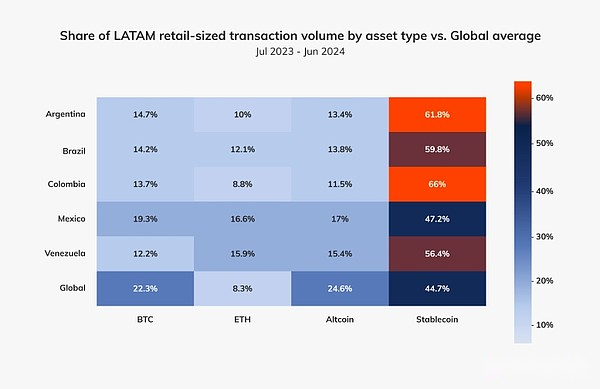
Furthermore, the value of retail-scale stablecoins received by Argentina (i.e. transactions below $10,000) grew faster than the value growth of any other asset type, which once again demonstrates that Argentines view stablecoins as a way to mitigate inflation and currency effectsdepreciation of means.Their interest in stablecoins highlights the role of cryptocurrencies in unstable markets and how citizens can better control their financial future by accepting cryptocurrencies, regardless of official monetary policy.
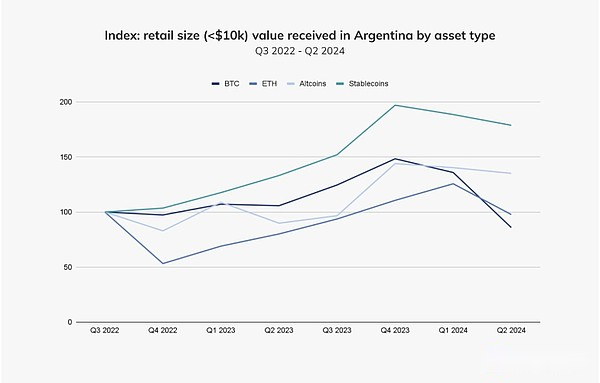
Venezuela’s cryptocurrency adoption remains strong despite uncertainty in the Maduro regime
Venezuela’s relationship with cryptocurrencies has been turbulent, marked by experiments such as the launch of the state-backed Petroleum Coin (PTR) (2018) and subsequent abrupt termination (2024), a form of Venezuelan oil and mineral wealthSupported stablecoins.and crack down on Bitcoin mining and block access to certain mainstream cryptocurrency exchanges.Meanwhile, its illegal oil trade has been entangled with cryptocurrency trading as the Maduro regime seeks ways to bypass economic sanctions, leading to a high-profile prosecution by the U.S. Department of Justice.These cryptocurrency-related events highlight a wider shift, with the Maduro regime using it as a weapon of corruption and citizens using it as a means to ensure financial independence.
However, despite this uproar, the Maduro regime has recently suggested a renewed interest in cryptocurrencies, but has not provided specific plans.Regardless of the outcome of such political developments, Venezuela remains one of the fastest-growing cryptocurrency markets in Latin America.Venezuela’s 110% year-on-year growth far exceeds that of any other country in the region.
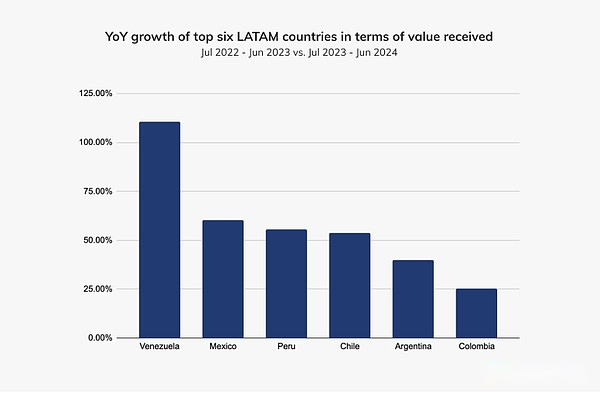
What drives this growth?First, Venezuelans appear to be attracted by cryptocurrencies to cope with the plunge in the Venezuelan Bolivar (VES).As shown below, there is a strong inverse relationship between the price of VES in USD and the value of the cryptocurrency received each month.A large number of media reports confirm this, indicating that the average Venezuelan population continues to seek stable means of store of value and hedge against the country’s economic crisis.
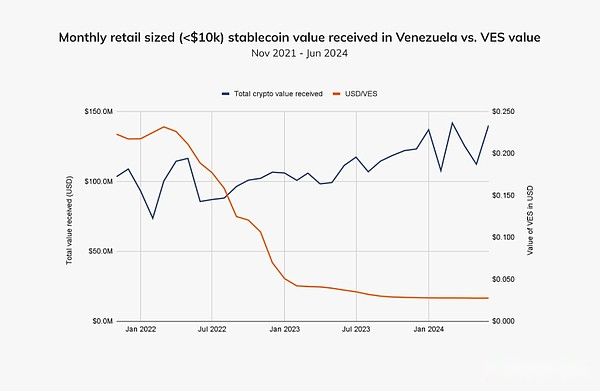
DeFi is another aspect of Venezuela’s cryptocurrency growth.Since 2022, centralized services have accounted for most of the value received in the country.However, there is growing interest in DeFi, which is particularly evident in the end of 2023.
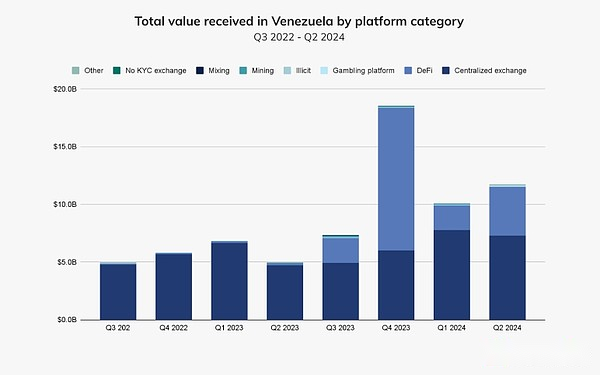
Although centralized services remain the most popular so far this year, DeFi’s growing market share will become an area of concern in the country in the near future, which could accelerate further if the Maduro regime explicitly supports cryptocurrency innovation..
Cryptocurrency activity accelerates in the Caribbean after FTX bankruptcy
In the years after the FTX crash, the crypto ecosystem in the Caribbean has experienced a period of uncertainty and activity has slowed down due to weaker trust in crypto platforms.However, starting from the end of 2023, the Caribbean has witnessed a recovery in cryptocurrency activity.Users appear to be turning to mainstream centralized exchanges (CEXs), such as Coinbase and Binance.

We interviewed David Templeman, a professional financial investigator at the Cayman Islands Financial Investigation Bureau, to learn more about how cryptocurrency activity in the Caribbean is changing.Specifically, in the Cayman Islands, Templeman noted that “the number of overseas customers seeking to establish legal entities in the Web3 and blockchain sectors last year has increased significantly compared to the last few years. These projects typically include tier 1 or tier 2, andWith a wide range of applications, from artificial intelligence, cross-chain infrastructure, gaming and data/cloud storage.”
As Templeman summed up, “The consequences of various collapses (FTX, TerraUSD/Luna, Celsius Network and Three Arrow Capital) put pressure on the industry to learn from its mistakes and build better oversight and guardrails.There is a strong community of blockchain and Web3 companies on the island that all actually exist and are legally registered here. “Corporate cryptocurrency activity in the Caribbean appears to be booming again, solidifying the subregion as adopted in the years to comeThe position of the key center.





